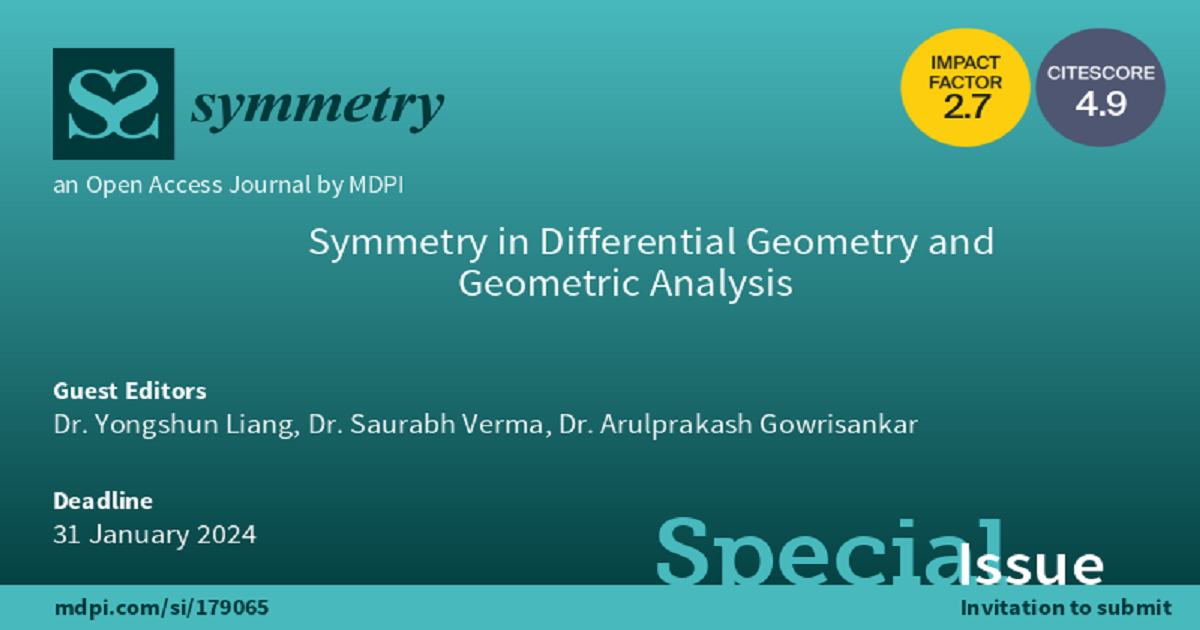- 2.2Impact Factor
- 5.3CiteScore
- 18 daysTime to First Decision
Symmetry in Differential Geometry and Geometric Analysis
This special issue belongs to the section “Mathematics“.
Special Issue Information
Dear Colleagues,
Fractal geometry is an important branch of mathematics that allows for the description of sets that are too intricate to fit into classical geometry. The concept of fractals was first introduced by Mandelbrot in the 1970s as a class of highly irregular sets usually presenting with self-similarity, infinite complexity, and a non-integral fractal dimension. Up to now, it has been hugely significant for the development of a variety of sciences. In mathematics, fractals originate from chaos and dynamic systems. Soon after their discovery, they began to appear in almost every field and can be systematically studied using classical and modern methods. In recent years, scholars have mainly focused on the following research objects: fractal dimensions of graphs, fractal interpolation and approximation, fractals and dynamical systems, self-similarity and Lipschitz equivalence, geometric measure theory, fractional calculus of fractal functions, fractal geometry, number theory, etc. In addition, fractals have been widely applied in other academic fields, such as physics, statistics, geology, material science, quantization theory, signal processing, computer image processing, pattern recognition, and more. Therefore, fractal geometry has increasingly shown its tremendous research value for both real life and scientific development.
It is well known that fractals are widely distributed in nature, such as mountains, landforms, cloud clusters, and so on. Mandelbrot once said that fractal geometry is the language of nature. There exist a lot of symmetries in natural objects with fractal characteristics, of which the most prominent one might be the Koch snowflake. Therefore, it is of great interest to explore the phenomena of symmetry or asymmetry in the fractal world.
This Special Issue aims to collect a series of high-quality papers from renowned experts from around the world to present the latest research on fractal geometry and its various applications. While the focus of this issue includes all the aspects mentioned above, we particularly welcome contributions from researchers who use the concepts of symmetry or asymmetry in their methodologies.
Dr. Yongshun Liang
Dr. Saurabh Verma
Dr. Arulprakash Gowrisankar
Guest Editors
Manuscript Submission Information
Manuscripts should be submitted online at www.mdpi.com by registering and logging in to this website. Once you are registered, click here to go to the submission form. Manuscripts can be submitted until the deadline. All submissions that pass pre-check are peer-reviewed. Accepted papers will be published continuously in the journal (as soon as accepted) and will be listed together on the special issue website. Research articles, review articles as well as short communications are invited. For planned papers, a title and short abstract (about 250 words) can be sent to the Editorial Office for assessment.
Submitted manuscripts should not have been published previously, nor be under consideration for publication elsewhere (except conference proceedings papers). All manuscripts are thoroughly refereed through a single-blind peer-review process. A guide for authors and other relevant information for submission of manuscripts is available on the Instructions for Authors page. Symmetry is an international peer-reviewed open access monthly journal published by MDPI.
Please visit the Instructions for Authors page before submitting a manuscript. The Article Processing Charge (APC) for publication in this open access journal is 2400 CHF (Swiss Francs). Submitted papers should be well formatted and use good English. Authors may use MDPI's English editing service prior to publication or during author revisions.
Keywords
- symmetries in fractal geometry
- symmetries in geometric analysis
- fractal dimension
- graphs of fractal functions
- fractal curves
- fractal surfaces
- fractal interpolation
- fractal function approximation
- dynamical systems
- iterated function systems
- fractal sets
- self-similar sets
- self-affine sets
- Lipschitz equivalence
- topological structures
- multifractals analysis
- geometric analysis
- geometric measure theory
- number theory
- diophantine approximation
- fractional calculus
- fractional differential equations
- numerical analysis in fractals
- fractals in nature
- applications of fractals, e.g., in physics, statistics, geology, material science, quantization theory, signal processing, computer image processing, pattern recognition

Benefits of Publishing in a Special Issue
- Ease of navigation: Grouping papers by topic helps scholars navigate broad scope journals more efficiently.
- Greater discoverability: Special Issues support the reach and impact of scientific research. Articles in Special Issues are more discoverable and cited more frequently.
- Expansion of research network: Special Issues facilitate connections among authors, fostering scientific collaborations.
- External promotion: Articles in Special Issues are often promoted through the journal's social media, increasing their visibility.
- e-Book format: Special Issues with more than 10 articles can be published as dedicated e-books, ensuring wide and rapid dissemination.

